So you want to add some drama to your space?
Pierre August-Renoir once said, “I’ve been 40 years discovering the queen of all colours was black.”
Black embodies the essence of the night, ebony, the expansive depths of outer space, and the deep mystery of the sea, evoking a captivating allure that envelops our world in secrecy and intrigue. Often associated with sophistication, elegance, and formality, black is a timeless colour cherished across various fields.
• Fashion: The “little black dress” is celebrated for its sleek and timeless appearance.
• Literature, Film, and Art: Black symbolizes the enigmatic and the hidden.
• Minimalist Design: Black is favoured for its clean, uncluttered look.
How The Colour Black Impacts Your Space
Black is a versatile colour that can be effectively utilized in your home. Its powerful presence and ability to pair well with other colours make it an essential tool in any designer’s palette. Black works well with various styles, from modern and minimalist to rustic and traditional.
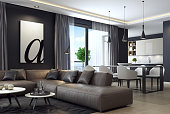
Modern and Minimalist Aesthetic
- Sleek Lines: Black is often used in modern and minimalist designs to create sleek, clean lines. It can be found in furniture, fixtures, and accents that emphasize simplicity and functionality.
- Contrast: Black provides a striking contrast to lighter colours, which can highlight architectural features and create visual interest. For instance, black window frames or doors can sharply contrast with white walls, making them stand out.
Elegance and Sophistication
- Luxury: Black is synonymous with luxury and sophistication. High-gloss black finishes on cabinetry or countertops can add a touch of opulence to kitchens and bathrooms.
- Formal Spaces: In dining rooms or home offices, black can create a formal, elegant atmosphere. Black dining chairs or desks paired with metallic accents (like gold or silver) can elevate the room's ambiance.
Balance and Harmony
- Neutral Backdrop: Black can act as a neutral backdrop that allows other elements to shine. This is particularly effective in spaces with bold artwork or colourful furnishings, where black walls or furniture create a balanced and harmonious look.
- Cohesion: Using black in various elements throughout a space, such as in picture frames, light fixtures, and textiles, can create a cohesive and well-thought-out design scheme.
Versatility in Style
- Traditional: In traditional interiors, black can be used in classic furniture pieces, such as a black leather Chesterfield sofa or a grand piano, adding a timeless charm.
- Industrial: In industrial-style spaces, black metal finishes and exposed structures (like beams and pipes) are commonly used to emphasize the raw and rugged aesthetic.
- Scandinavian: In Scandinavian design, black is often used sparingly to add contrast and definition. Black accents, such as pendant lights or dining chairs, can punctuate the predominantly light and airy spaces typical of this style.
Practicality and Functionality
- Durability: Black materials, such as black granite or quartz countertops, are durable and resistant to stains and scratches, making them practical choices for high-use areas like kitchens and bathrooms.
- Maintenance: Black flooring, whether hardwood, tile, or carpet, can be easier to maintain as it doesn't show dirt and wear as easily as lighter colours.
Psychological Impact
- Cozy and Intimate: Black can make large spaces feel more intimate and cozy. Dark walls in a bedroom or living room can create a warm, enveloping atmosphere conducive to relaxation.
- Focus and Productivity: In home offices, black can enhance focus and productivity by reducing distractions. A black desk or shelving can create a professional and organized environment.
Examples in Interior Design
- Black Accent Walls: Using black paint or wallpaper on one wall can create a focal point in a room, adding depth and sophistication without overwhelming the space.
- Black Kitchen Cabinets: Black cabinetry paired with lighter countertops and backsplashes can create a striking and modern kitchen design.
- Black Bathroom Fixtures: Black faucets, showerheads, and accessories can give bathrooms a contemporary and luxurious feel.
- Black Statement Furniture: Pieces like a black leather sofa, black velvet armchair, or black dining table can serve as statement pieces that anchor a room’s design.
Is black the sum of all colours or the absence of all colours? The centuries-old debate. Is black really a colour?
Absence of All Colors: In the context of light, black is considered the absence of all colours. When there is no light present, we perceive black. For instance, in a completely dark room with no light sources, everything appears black because no light reaches our eyes. It is when all visible wavelengths of light are absorbed and none are reflected or emitted to our eyes.
Sum of All Colors: In the realm of pigments and paints, black can be seen as the sum of all colours. Mixing different pigments absorbs all wavelengths of light, resulting in black.
Enough about the science of it all… let’s learn how to use black!
Here are 7 ways to paint with black in your home… and the right amount.
Using Black for Your Home's Exterior
1) Having a Black Roof
If the “fifth wall” on your home’s interior is the ceiling, then the ‘fifth wall” on your home’s exterior is your roof. Choosing a dark charcoal or black roof can add instant dramatic appeal to your home. Bonus: with a black roof you can have more versatility in choosing your main colour scheme.
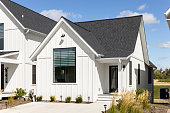
2) Using Black For Visual Direction
Certain homes can look spectacular completely painted in black, but…
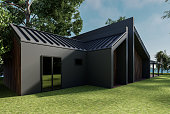
It's important to consider using black wisely with a balanced and harmonious structure. Black can be used to create visual pathways that guide the viewer’s eye through the composition. For example, black lines or shapes can lead the viewer from one element to another. Black elements repeated at regular intervals can create a steady, predictable rhythm.
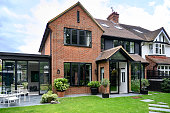
3) Painting The Front Door Black
It’s simple and classic and the perfect backdrop to highlight beautiful hardware. Placing black elements equally on either side of a central axis can provide a sense of stability. This door would be lovely with two black planters on either side to enhance the symmetrical feel.
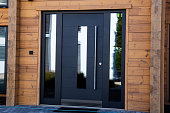
Matisse in 1946 declared; “When I didn’t know what colour to put down, I put down black. Black is a force: I used black as ballast to simplify the construction.”
Using Black for Your Home's Exterior
4) Your Powder Room or Bathroom
Give your powder room a showstopper look. Using black and white can help to simplify the overall design and focus on the mystique you are trying to convey. Look how the contrast between the two colours can be used to create a dramatic effect to highlight certain aspects of the design. Pairing black with wood and white offers an appealing contrast.
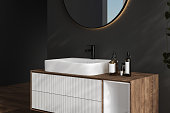
5) Painting Your Fireplace Black
Consider using black on your fireplace. It quickly becomes the focal point of the room and adds volume to the space. Pairing with natural textures and soft muted tones captures a feeling of comfort and relaxation.
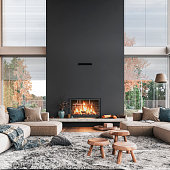
6) Black Elements in Open-Concept Rooms and Kitchen
In your open-concept room, varying the size and placement of black elements can create a more dynamic, flowing rhythm that guides the viewer’s gaze less predictably.
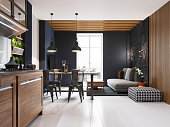
Black offers strong contrast when paired with lighter colours, especially white. This contrast can make elements stand out and draw attention.

7) Incorporate Greenery With Black Walls
Plants can soften the boldness of black and add a touch of nature to the space.

These are some of our favourite black paint colours
EX024 Ebony - our deepest black
0515 Silent Sea - from the depths of the mysterious ocean
0529 Black Licorice - a quieter black, a bit less punch
0536 Subway - our softest black that wraps around you like cashmere
Want to get started? Here are quick steps to paint a black wall
1. Prepare the Room
• Remove Furniture: Clear the room of as much furniture as possible. Cover any remaining furniture and the floor with drop cloths.
• Clean the Wall: Wipe down the wall to remove dust and dirt. Use a mild detergent if necessary, then allow it to dry completely.
2. Protect Surfaces
• Tape Off Areas: Use painter’s tape to protect trim, ceiling edges, and any areas you don’t want to be painted. Make sure the tape is applied smoothly to prevent paint from seeping underneath.
3. Prepare the Wall
• Fill Holes and Cracks: Use spackle or putty to fill any holes or cracks in the wall. Let it dry, then sand smooth.
• Sand the Wall: Lightly sand the entire wall to create a smooth surface for the paint to adhere to. Wipe down with a clean cloth to remove dust.
4. Prime the Wall
• Tinted Primer: Use a gray-tinted primer to help the black paint cover better. Apply the primer evenly with a roller, using a brush for edges and corners. Let it dry completely.
5. Paint the Wall
• First Coat: Pour the black paint into the paint tray. Use a roller to apply the paint in large, even strokes, working in small sections at a time. Use a brush for the edges and corners. Allow the first coat to dry completely.
• Second Coat: Apply a second coat of black paint to ensure even coverage and a rich, deep colour. Let it dry thoroughly.
• Additional Coats: Depending on the quality of the paint and the desired depth of colour, you might need a third coat. Ensure each coat is completely dry before applying the next.
6. Remove Tape and Clean Up
• Remove Painter’s Tape: Carefully remove the painter’s tape before the final coat dries completely to avoid peeling off any paint.
• Touch-Up: Use a small brush to touch up any areas where the paint might have bled under the tape or if there are any imperfections.
• Clean Tools: Clean your brushes, rollers, and paint tray immediately after use to keep them in good condition.
7. Final Touches
• Inspect the Wall: After the paint is fully dry, inspect the wall for any missed spots or uneven areas and touch them up as needed.
• Rearrange Furniture: Once the paint is completely dry and cured (usually a few days), move your furniture back into place and enjoy your new black wall!
Tips for Success
• Quality Paint: Invest in high-quality paint for better coverage and durability.
• Proper Ventilation: Ensure the room is well-ventilated while painting to help the paint dry faster and reduce fumes.
• Test Area: If unsure about the shade of black, paint a small test area first to see how it looks in different lighting.
Painting a black wall can dramatically change the ambiance of a room, making it feel modern and chic. By following these steps, you’ll achieve a professional-looking finish that enhances your space.
Are you ready to get started? Visit your nearest Cloverdale Paint store now and speak with any of our Customer Service Representatives.